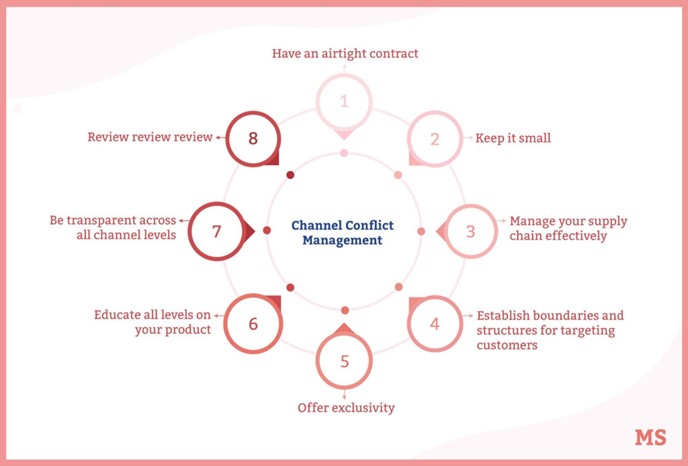In today's competitive environment, it's essential to establish strong relationships with potential customers, and multiple B2B channel partners help to achieve that. But what happens when companies don't agree on terms or pricing?
It can lead to a breakdown in communication and, ultimately, to lost deals.
This article explores the causes of B2B sales channel conflicts and offers solutions to prevent them from happening.
What Is Channel Conflict?
Channel partners or partnerships are collaborations between the companies that produce products or services and the companies that distribute, market, and sell them.
B2B has three main channel types:
- Communication channels receive and deliver messages from and to your target audience (e.g., social media).
- Distribution channels market, deliver, or sell your products or services on your behalf (e.g., wholesalers).
- Service channels carry out the transactions needed for your product to reach the consumer (e.g., transport services).
In B2B, your main channel partners are e-commerce, your physical store, your in-store partners, and your online partners.
Advantages of using such channels include reaching a wider target audience and bettering your B2B customer experience. Disadvantages include the unreliability of channels (leading to conflict) and the potential to oversaturate the market.
It's almost impossible for everyone to get along all the time, so why do we expect that from our channel partners? Answer: we don't. Hence, "channel conflict," a term used to describe issues between channel partners.
Channel conflict comes in various types:
- Vertical-level conflict is a conflict between two different partners at different levels within the distribution chain.
- Horizontal conflict is a conflict between two partners that are both at the same level within the distribution chain.
- Multichannel conflict is a conflict between multiple channels when they are in direct competition and are all competing in the same market to sell the same product but at a different price.
Channel conflict is experienced in nearly every single B2B organization, no matter the shape or size. Although channel conflict doesn't necessarily mean the downfall of your business, it is still important to identify the cause and efficiently manage the situation to minimize its impact.
Potential Causes of Channel Conflict
Because every business is unique in its offering, structure, and channel partnerships, it is almost impossible to predict every occurrence that may cause channel conflict. Here, however, are several common causes.
1. Inconsistent Pricing
Having huge discrepancies in your prices between distribution channels can lead to price wars among the channels.
Price wars inevitably lead to a loss of customers for partners because prices skyrocket and sales decrease. Inconsistent pricing can be caused by an inability to negotiate with one another, or simply each partner wants to set its own price.
2. Unclear or Incompatible Goals
Each of your partners should be aware of what your goals are so that you are all working toward them.
For example, if you want to increase your sales through new channels, then you need to ensure that those new channels are compatible with your current ones, as well as aligned with their goals. If not, you'll end up losing money and wasting resources.
3. Lack of Trust
Trust is something that takes time to build, especially in people who have never worked together before. It's important to work on building trust with your channel partners or you risk having a bad relationship that results in major-account churn.
4. Making Decisions Without Informing Your Channel Partners
The most common cause of channel conflict is poor communication. You must communicate clearly and effectively with your partners about how you want things done and what you expect from them. That includes communicating expectations around deadlines, quality standards, costs, etc.
It's also vital to be transparent with your partners. They should know exactly what you're doing and why you're doing it. Transparency helps prevent miscommunication and misunderstandings.
5. Poor Understanding of Your Value Proposition
When working with partners, it's important to understand what the value proposition of your product or service is.
- What do you offer? Why does it stand out above others of its type?
- What makes you special?
Understanding that and being able to articulate it to your partners is essential for any market strategy. Every partner needs to be on the same page—much as with goals.
6. Not Listening to Feedback
Feedback is crucial to improving your business and ensuring that you're making good decisions. Asking questions and seeking feedback from your partners will help your business and avoid future conflicts.
7. Oversaturation
Having too many partners can result in oversaturation of the market. That can lead to conflict because your partners will be competing among themselves in addition to competing against your direct competitors.
Also, you may find that some of your partners aren't meeting your expectations. Confronting that is another form of potential conflict.
8. Disregarding the Need for Convenience
If you disregard people's need for convenience when they are buying, as well as changes in their buying habits, you risk increasing the competition for your partners as customers will turn to others who do meet their needs.
That could lead to multichannel conflict as your customers shop between channels rather than remaining loyal to just one.
How To Avoid and Manage B2B Channel Conflict

Source: MarketSplash
1. Have an airtight contract
Having an airtight contract ensures that everyone knows the obligations and responsibilities involved. It also ensures that there are no surprises further down the line—for you or your partners.
2. Keep it small
Limiting your channel partners to only those who provide high-value services will make managing conflict easier.
For example, if you work with a company that provides printing services but not website design, you'll likely have fewer issues with your relationship. Similarly, if you work with companies that sell multiple products, you might want to limit your relationships to those that specialize in certain product lines.
3. Offer exclusivity to partners
Exclusivity takes keeping it small to the next level.
Exclusivity means that you have only one partner. That greatly reduces the chances of conflict, but it also reduces your reach and potential sales. It is up to you to decide which one you think is more important.
Another way to take on exclusivity is to offer exclusive products to different partners, setting them up with a value proposition unique from any of your other channels.
4. Manage your supply chain effectively
You need to be a constant managerial presence across your supply chain and partners. You must monitor your partners closely and ask them about their performance on a regular basis.
If you're having trouble finding out what's going on with your partners, consider using a third-party management service. Such services offer monitoring software that allows you to keep track of everything from inventory levels to customer satisfaction. They can even alert you when something goes wrong.
5. Establish boundaries and structures for targeting customers
Establishing boundaries for targeting customers beforehand ensures that there is little overlap between each partner's target audience, meaning each partner is getting a fair market share and a fair chance to generate revenue without having to worry about another partner targeting the same customers. That will also result in your partners' being able to establish a loyal customer base.
6. Be transparent across all channel levels
Again, clarity is vital when dealing with your partners. Make sure they know exactly what you want and expect from them. That goes beyond simply asking for clarification. Be clear about everything.
For example, make sure that you're aware of the quality standards required by your partners.
Also, ask for updates as often as possible.
7. Educate all levels on your product
Every channel partner needs to understand everything about your product. Having a full understanding will allow partners to get the most out of your partnership, improve their sales productivity, and better perform their functions.
8. Review, review, review
Continue to review your channel partners and their performance throughout your relationship. You can then remove partners that are not performing in the way you expected. By reviewing your partners, you can also ensure standardization and fairness in pricing and marketing efforts.
* * *
B2B channel conflict is natural. And although it has negative consequences for your business, it is something that can be minimized and managed.
Managing your channel partners should be done on a continual basis. If you do it correctly, you'll have fewer issues with conflicts and more success.
More Resources on B2B Channel Partnerships
How to Build a Solid Channel-Partner Marketing Plan
Five Tips for Small B2B Companies That Depend on Big Channel Partners
Good Money After Bad? Your Channel Partners and Your Co-Op Dollars




